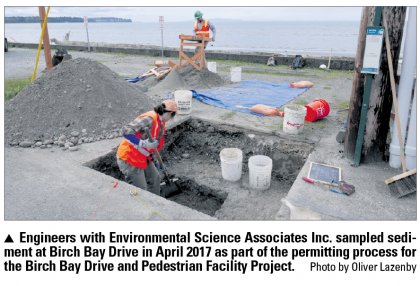Missing January deadline could jeopardize federal funding
By Oliver Lazenby
Without an agreement in the next month from the Lummi Indian Business Council, the 1.6-mile Birch Bay beach restoration project known as the Birch Bay berm will be delayed for another year and some funding for the $11.5 million project could be in jeopardy, according to Whatcom County officials.
At a December 4 meeting, the Whatcom County Council approved writing to the Lummi Indian Business Council urging it to sign agreements crucial to permitting the beach restoration project.
“If Whatcom County cannot find a way to full approval by mid-January 2019, then public works will be unable to bid the project for 2019 construction,” according to the letter. “The $1.6 million federal grant that Lummi Nation argued successfully for extension on our collective behalf will be forfeited.”
Other permits and issues have held up the project over the last few years – it was once scheduled to begin in the fall of 2016 – but all remaining permits and approvals now hinge on the tribe, the county and several other agencies agreeing on how to handle cultural artifacts and how to mitigate environmental impacts from construction.
The project will add approximately 130,000 cubic yards of gravel and sand to the beach to raise it and protect from erosion. It aims to restore the beach to a natural state and replace a series of seawalls and other ineffective concrete structures. Plans include bike lanes, paths and other pedestrian improvements to Birch Bay Drive, which is popular with walkers.
 Though the project will primarily add material to the beach, the county will excavate for 14 drainage pipes along the project and the digging could unearth tribal artifacts. Whatcom County public works engineering manager Jim Karcher said that soil samples taken by a county contractor in April 2017 turned up something of interest to the tribe.
Though the project will primarily add material to the beach, the county will excavate for 14 drainage pipes along the project and the digging could unearth tribal artifacts. Whatcom County public works engineering manager Jim Karcher said that soil samples taken by a county contractor in April 2017 turned up something of interest to the tribe.
Tribal agreement will fulfill a crucial part of the needed National Environmental Policy Act (NEPA) permit. In addition to an agreement about what to do with cultural artifacts, the county’s letter to the Lummi Indian Business Council asks for a separate agreement that would give the Lummi Natural Resources department $120,000 for environmental monitoring and mitigation during berm construction.
The Lummi Indian Business Council and the Tribal Historic Preservation Office didn’t respond to requests for comment.
Whatcom County began working with the Lummi Nation who acted as lead for tribes with historic ties to the area including the Nooksack, Suquamish, Swinomish and Samish tribes, in January 2015, according to the county letter.
The NEPA permit isn’t the only thing that’s delayed construction. Obtaining approximately 40 property easements along the beach also took longer than the county expected. Currently, the county needs one final easement from a property owner who has made it contingent on the project permits, Karcher said.
The $11.5 million project was first proposed in 1975 as a way to restore the eroding beach caused in the early 1950s by the U.S. Army Corps of Engineers which removed between 200,000 and 300,000 cubic feet of material from the beach for the Blaine Air Force Station and other facilities.
Though permitting the berm has dragged on years past deadline, county officials say they remain committed to the project. However, failing to reach an agreement this year could be a bigger setback than the county has yet encountered. “If the project is delayed further, then there will have to be a major reconsideration of the funding package,” Karcher said.
Comments
No comments on this item Please log in to comment by clicking here